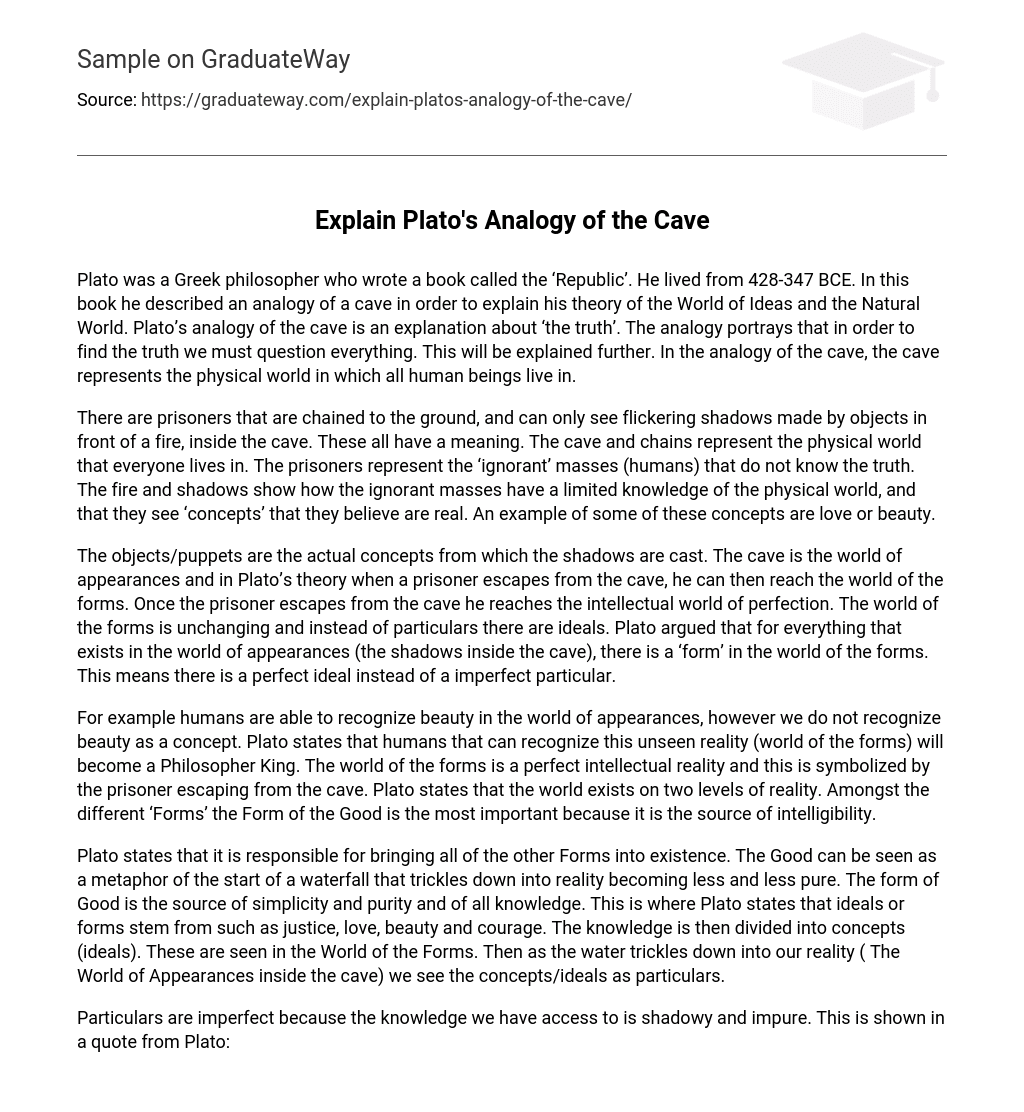Plato, a Greek philosopher, authored a book titled the ‘Republic’ during the period of 428-347 BCE. Within this work, he elucidated his theory of the World of Ideas and the Natural World through an analogy known as the cave. This analogy serves as an explanation of ‘the truth’, asserting that to uncover it, one must question all that exists. The cave analogy symbolizes the physical realm in which all individuals reside.
Within the cave, prisoners are shackled to the ground, witnessing mere flickering shadows that result from objects placed before a fire. These shadows, although significant, symbolize the physical world in which all individuals reside. The prisoners themselves represent the ignorant masses or humans who lack awareness of the truth. Furthermore, the fire and shadows exemplify the limited understanding that these ignorant masses possess about the physical realm. They perceive abstract concepts such as love or beauty as genuine realities.
In Plato’s theory, the objects/puppets represent the actual concepts that create shadows in the cave, which symbolizes the world of appearances. According to Plato, when a prisoner manages to escape from the cave, they are able to enter the world of the forms. This intellectual realm of perfection is unchanging, unlike the world of appearances. Instead of imperfect particulars, the world of the forms consists of idealized versions of everything that exists in the world of appearances (the shadows within the cave). Plato argued that every thing in the world of appearances has a corresponding ‘form’ in the world of the forms, representing a perfect and idealized state.
In the realm of appearances, humans have the ability to perceive beauty, but they fail to appreciate it as a concept. Plato asserts that individuals who can apprehend the unseen truth (the world of forms) will achieve the status of a Philosopher King. The world of forms represents a flawless intellectual reality, exemplified by a prisoner breaking free from a cave. According to Plato, reality exists on two planes. Within the various forms, the Form of the Good holds utmost significance as it serves as the origin of comprehensibility.
According to Plato, the Good is responsible for the creation of all other Forms. It can be compared to the beginning of a waterfall, which gradually becomes less pure as it enters reality. The form of Good is the origin of simplicity, purity, and knowledge. Plato argues that ideas or forms such as justice, love, beauty, and courage originate from the Good. Knowledge is then divided into concepts or ideals, which are present in the World of Forms. As these concepts trickle down into our reality (referred to as the World of Appearances or the cave), they manifest as specific instances or particulars.
Particulars are imperfect because the knowledge we have access to is shadowy and impure. Plato’s quote, ‘And we say that the particulars are objects of sight but not of intelligence, while the forms are the objects of intelligence but not of sight,’ demonstrates this. Plato’s analogy of the cave illustrates his belief in the World of appearances and the World of the forms. This analogy effectively represents his beliefs. Additionally, Plato’s theory of the Forms fails to provide an explanation for the nature of reality.
Plato’s theory of the Forms is a divisive topic. While some argue that it accurately explains the nature of reality, others hold a contrary view. In this discussion, different viewpoints surrounding this theory will be explored, offering a comprehensive analysis. Plato himself disagrees with the assertion that the forms are unnecessary for the physical world’s existence, maintaining that they provide essential knowledge about it. For Plato, the physical world relies on the Forms for its very being. On the other hand, Neo-Platonists align themselves with Plato’s thinking and support his stance. However, scientists would side with the opposition, pointing out that there is no concrete evidence to support the existence of the forms. Empirical in nature, scientists seek proof and facts to substantiate their claims.





